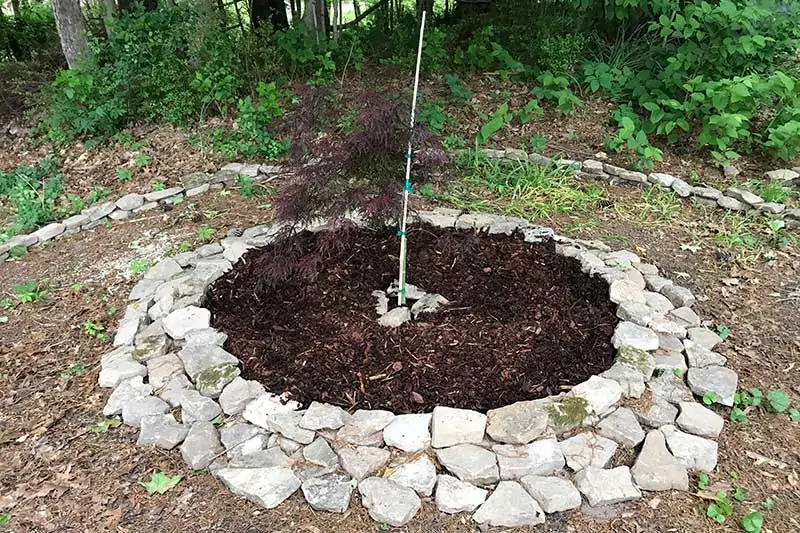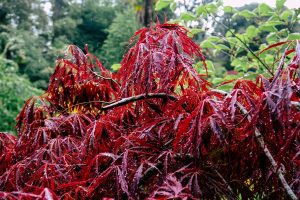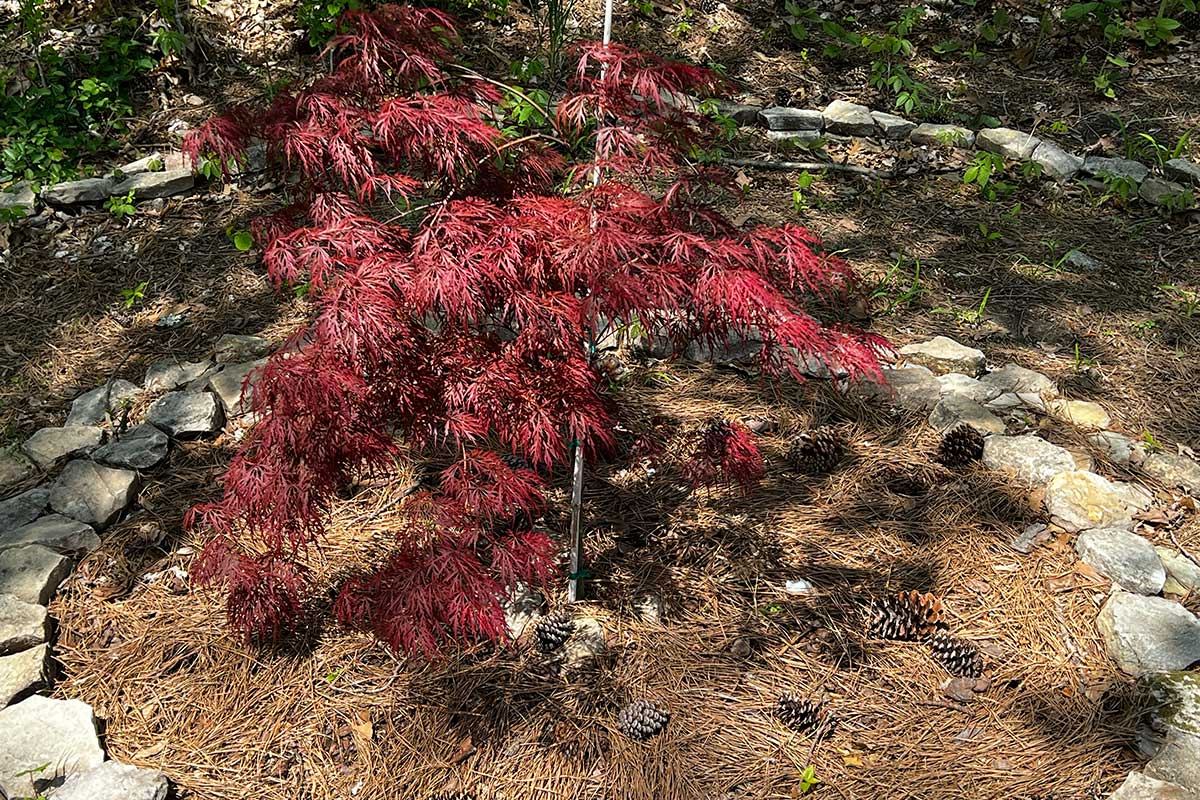The Crimson Queen (Acer palmatum) Japanese maple tree is one of the prettiest dwarf trees with low branching and a delicate, weeping form. Adding them to your landscape will give you a stunning pop of color, and you can conveniently plant them in any size garden. To ensure you Crimson Queen is healthy and thriving, you’ll want to understand the best ways to care for this maple tree. What are the best soils for planting? Can a Crimson Queen tolerate full sun? Find out answers to these questions and more to help you properly care for this beautiful tree.
Key takeaways
- Crimson Queens can tolerate full sun with proper watering practices
- Adding mulch and full-purpose fertilization will help your tree thrive
- Crimson Queens grow around 10 feet tall and have red foliage from spring to fall
Can a Crimson Queen tolerate full sun?
Yes, Crimson Queen Japanese maples can grow in full sun to part shade conditions. The plant hardiness zones for Crimson Queens are zones 5 through 9. Although they do best in partial to full shade, these hardy trees can tolerate full sun in coastal areas and morning sun in hotter clients.
You can typically grow them in full sun throughout the day in the northern states of its range. However, in the southern states, including St. Louis, it’s best to have part afternoon shade after full sun in the morning. If you don’t keep the soil moist, it can also lead to scorched foliage in full sun locations with hot summers.
How do you protect a Japanese maple from the sun?
Adding a layer of 3 to 4 inches thick mulch around the base can protect your Crimson Queen Japanese maple from too much sun. This method helps retain soil moisture and keeps the roots cool, especially since the tree’s roots are shallow and near the soil’s surface. Shredded bark or well-composted humus are common mulch used for Crimson Queens.
How do you take care of a Crimson Queen?
In the states with hotter climates, you’ll want to make sure you adopt proper watering practices to ensure your Crimson Queen thrives for years. These trees are drought-tolerant once they’ve matured but will need heavy watering twice a week in the beginning. If the soil is dry, increase the frequency to 3 to 4 times a week.
You’ll also want to prune your Crimson Queen at a minimum and it should be done in late fall to mid-winter. If you prune your tree in spring or summer, it will be more vulnerable to bleeding. In the spring, fertilize your tree with an all-purpose fertilizer.
What kind of soil does a Japanese maple tree need?
It’s best to grow your Crimson Queen in organically rich, moist soils that are slightly acidic and well-drained. They can also thrive in sandy loam soils and will tolerate heavy clays. Soils to avoid when planting your Crimson Queen are highly alkaline soils or salty soils.

How big do crimson Queen Japanese maples get?
The Crimson Queen is a small tree or deciduous shrub, making it smaller than most maples. It typically grows between 8 to 10 feet tall and 10 to 12 feet wide. Rarely will you see one growing above 12 feet tall.
You can easily fit them into tighter landscape spaces, and they make great accent pieces around your patio, yard border, or rock garden. Planting them near a pond or water garden will also showcase the beautiful cascading form.
Does Crimson Queen lose leaves?
Yes, the Crimson Queen will lose its leaves in the winter. However, the stems and stalks remain red making it a beautiful winter plant. Typically, the leaves emerge bright red in the spring, turn burgundy in the summer, and will be a crimson red in the fall, especially in full sun. If you find our crimson Queen is losing leaves in the spring, it could be due to not enough moisture or pests such as the maple petiole borer.

What is the most sun-tolerant Japanese maple?
Although the Crimson Queen is commonly referred to as Japanese Maples, other Japanese maple varieties can also tolerate full sun conditions with good watering practices. One of the most sun-tolerant is the Full Moon Maple (Acer japonicum ‘Aconitifolium’) that can thrive in full morning sun in southern states like Oklahoma, Alabama, and Texas. They are a green-leaf variety that turns shades of red and orange in the fall.
Other Japanese maples varieties to consider for your landscape include:
- Shania: compact and slow-growing, the leaves are red in spring, maroon in summer, and brilliant orange in fall
- Sangu Kaku: or Coral Bark Maple has bright green leaves in the spring, darker green in the summer, and a peach-gold in fall
- Seiryu: vase-shaped and a great shade tree, the leaves are touched with red in spring, pure green in summer, and gold with red accents in fall
- Emperor I: a moderate grower with dark red foliage in the spring and summer and scarlet red in the fall
Conclusion
While the Crimson Queen grows best in partial shade, they can tolerate full sun in certain regions if you keep the soil moist. For southern states with hotter summers, it’s best to place them in a location where there will be partial afternoon shade.
Proper care, including mulching, fertilizing, and limited pruning will help these trees thrive for years as a beautiful, red accent piece to your landscape. You can also pair them with other sun-tolerant Japanese maple varieties for a robust garden.
